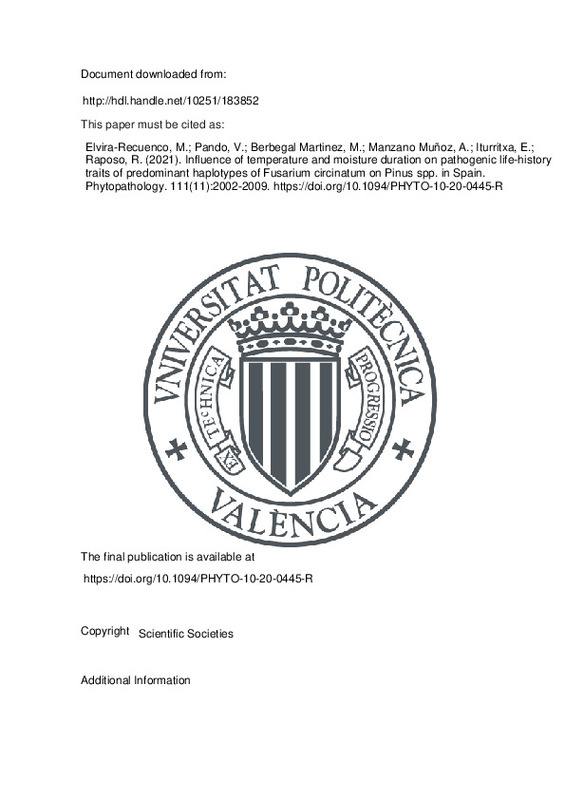JavaScript is disabled for your browser. Some features of this site may not work without it.
Buscar en RiuNet
Listar
Mi cuenta
Estadísticas
Ayuda RiuNet
Admin. UPV
Influence of temperature and moisture duration on pathogenic life-history traits of predominant haplotypes of Fusarium circinatum on Pinus spp. in Spain
Mostrar el registro sencillo del ítem
Ficheros en el ítem
| dc.contributor.author | Elvira-Recuenco, Margarita
|
es_ES |
| dc.contributor.author | Pando, Valentin
|
es_ES |
| dc.contributor.author | Berbegal Martinez, Monica
|
es_ES |
| dc.contributor.author | Manzano Muñoz, Aranzazu
|
es_ES |
| dc.contributor.author | Iturritxa, Eugenia
|
es_ES |
| dc.contributor.author | Raposo, Rosa
|
es_ES |
| dc.date.accessioned | 2022-07-06T06:48:17Z | |
| dc.date.available | 2022-07-06T06:48:17Z | |
| dc.date.issued | 2021-11 | es_ES |
| dc.identifier.issn | 0031-949X | es_ES |
| dc.identifier.uri | http://hdl.handle.net/10251/183852 | |
| dc.description.abstract | [EN] Pathogen life history traits influence epidemic development and pathogen adaptive ability to interact with their hosts in different environments. Reduced traits variation may compromise pathogen evolutionary potential, which is particularly important for introduced pathogens. Fusarium circinatum (cause of pine pitch canker) is an invasive fungal pathogen in Europe, with current distribution restricted to forest stands of Pinus radiata and Pinus pinaster in northern Spain and Portugal. This study aimed to quantify pathogenic traits of Spanish isolates of F. circinatum, with two of the strains representing the two dominant haplotypes in the Spanish population. Disease severity was measured on P. radiata, analyzing the influence of temperature and moisture duration on infection as well as the influence of temperature on spore germination, sporulation, and mycelial growth. Results indicated that the isolate representing the most common haplotype caused more severe disease on P. radiata at 25 and 30 degrees C compared with the second most common haplotype but caused less severe disease at 15 degrees C. Spore germination was higher for the most common haplotype, which produced more spores at 20 and 25 degrees C. The isolate showed hyphal melanization at 5 degrees C, which has been associated with survival and may be important because no resting structures have been described for F. circinatum. Our study determined that longer moisture periods during infection result in more severe disease from 7 to 24 h, regardless of the isolate virulence. This is the first study on virulence of the most abundant haplotypes of F. circinatum in Spain as affected by temperatures and moisture | es_ES |
| dc.description.sponsorship | This research was supported by Ministerio de Economia y Competitividad (Subprograma de Proyectos de I+D orientado a los Recursos y Tecnologias Agrarias en coordinacion con las Comunidades Autonomas) projects RTA 201300048-C03-01 and RTA 2017-00063-C04-01. | es_ES |
| dc.language | Inglés | es_ES |
| dc.publisher | Scientific Societies | es_ES |
| dc.relation.ispartof | Phytopathology | es_ES |
| dc.rights | Reserva de todos los derechos | es_ES |
| dc.subject | Cardinal temperatures | es_ES |
| dc.subject | Disease control and pest management | es_ES |
| dc.subject | Disease resistance | es_ES |
| dc.subject | Germination | es_ES |
| dc.subject | Infection period | es_ES |
| dc.subject | Melanization | es_ES |
| dc.subject | Monterey pine | es_ES |
| dc.subject | Pitch canker disease | es_ES |
| dc.subject | Sporulation | es_ES |
| dc.subject | Virulence | es_ES |
| dc.subject.classification | PRODUCCION VEGETAL | es_ES |
| dc.title | Influence of temperature and moisture duration on pathogenic life-history traits of predominant haplotypes of Fusarium circinatum on Pinus spp. in Spain | es_ES |
| dc.type | Artículo | es_ES |
| dc.identifier.doi | 10.1094/PHYTO-10-20-0445-R | es_ES |
| dc.rights.accessRights | Abierto | es_ES |
| dc.contributor.affiliation | Universitat Politècnica de València. Departamento de Ecosistemas Agroforestales - Departament d'Ecosistemes Agroforestals | es_ES |
| dc.description.bibliographicCitation | Elvira-Recuenco, M.; Pando, V.; Berbegal Martinez, M.; Manzano Muñoz, A.; Iturritxa, E.; Raposo, R. (2021). Influence of temperature and moisture duration on pathogenic life-history traits of predominant haplotypes of Fusarium circinatum on Pinus spp. in Spain. Phytopathology. 111(11):2002-2009. https://doi.org/10.1094/PHYTO-10-20-0445-R | es_ES |
| dc.description.accrualMethod | S | es_ES |
| dc.relation.publisherversion | https://doi.org/10.1094/PHYTO-10-20-0445-R | es_ES |
| dc.description.upvformatpinicio | 2002 | es_ES |
| dc.description.upvformatpfin | 2009 | es_ES |
| dc.type.version | info:eu-repo/semantics/publishedVersion | es_ES |
| dc.description.volume | 111 | es_ES |
| dc.description.issue | 11 | es_ES |
| dc.identifier.pmid | 33754808 | es_ES |
| dc.relation.pasarela | S\437675 | es_ES |







![[Cerrado]](/themes/UPV/images/candado.png)

